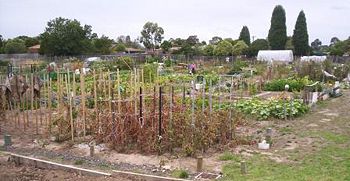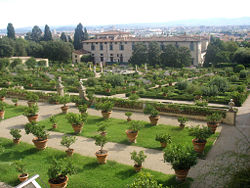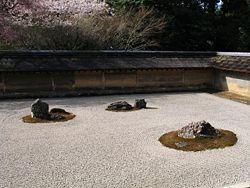Gardening
Gardening is the practice of growing flowering plants, vegetables, and fruits. Residential gardening most often takes place in or about a residence, in a space referred to as the garden. Although a garden typically is located on the land near a residence, it may also be located in a roof, in an atrium, on a balcony, in a windowbox, or on a patio or vivarium. Gardening can provide a satisfying emotional outlet for the individual who loves to be outdoors or a year-round pursuit for those fortunate enough to have a greenhouse. Gardening not only connects people to the natural world in a fun and puposeful way, but can be very educational and lead to a lifelong love of the plant world. People of all ages can enjoy the experience of gardening. Children, especially, can be introduced to the mysteries of life, growth and death through observing this in a small garden of their own.
There is a saying of a person having a "green thumb" of one who is a successful gardener. In the USA, there are master gardener programs promoted by many university extension programs throughout the nation for the purpose of not only educating the invidual but for spreading the knowledge of ideal and successful gardening practices to the public at large. Most master gardeners are required to volunteer a certain number of hours per year to help their communities with their gardening expertise.
Gardening also takes place in non-residential green areas, such as parks, public or semi-public gardens (botanical gardens or zoological gardens), amusement and theme parks, along transportation corridors, and around tourist attractions and hotels. In these situations, a staff of gardeners or groundskeepers maintains the gardens.
Indoor gardening is concerned with the growing of houseplants within a residence or building, in a conservatory or a greenhouse. Indoor gardens are sometimes incorporated as part of air conditioning or heating systems.
Water gardening is concerned with growing plants adapted to pools and ponds. Bog gardens are also considered a type of water garden. These all require special conditions and considerations. A simple water garden may consist solely of a tub containing the water and plant(s).
Container gardening is concerned with growing plants in any type of container either indoors or outdoors. Common containers are pots, hanging baskets, and planters. Container gardening is usually used in atriums and on balconies, patios, and roof tops.
History
Gardening for food extends far back into prehistory. Ornamental gardens were known in ancient times, a famous example being the Hanging Gardens of Babylon. The ruins of ancient Roman history reveals that wealthy Romans had gardens to beautify their homes and estates.
Gardens and gardening since ancient times have not only been created for the asthetic beauty for people to enjoy but have often been created to attract special insects such as butterflies or various types of birds and animals. There are gardens grown for fragrance, medicinal purposes and to structurally enhance public and private properties.
Gardening compared to farming
In respect to its food producing purpose, gardening is distinguished from farming chiefly by scale and intent. Farming occurs on a larger scale, and with the production of saleable goods as a major motivation. Gardening is done on a smaller scale, primarily for pleasure and to produce goods for the gardener's own family or community. There is some overlap between the terms, particularly in that some moderate-sized vegetable growing operations called market gardening which is considered to be farming on a small scale.
The key distinction between gardening and farming is essentially one of scale: gardening can be a hobby or an income supplement, but farming is generally understood as a full-time or commercial activity, usually involving more land and quite different practices. One distinction is that gardening is labor-intensive and employs very little infrastructural capital, typically no more than a few tools, e.g. a spade, hoe, basket and watering can. By contrast, larger-scale farming often involves irrigation systems, chemical fertilizers and an investment in heavy equipment to prepare, plant and harvest crops.

In part because of labor intensity and aesthetic motivations, gardening is very often much more productive per unit of land than farming. In the former Soviet Union, half the food supply came from small peasants' garden plots on the huge government-run collective farms, although they were tiny patches of land.
The term precision agriculture is sometimes used to describe gardening using intermediate technology (more than tools, less than harvesters), especially of organic varieties.
Community gardening is a growing movement across the USA and in some countries such as Great Britain and Australia. Small plots are made available to urban dwellers to plant for personal use. Many community gardens can be found on land that is vacant, and often in inner city areas. Community gardening brings people together, beautifies the neighborhood and create a sense of ongoing care for the local environment.
Gardens as art
Garden design is considered to be an art in most cultures, distinguished from gardening, which generally means garden maintenance. In Japan, for instance, Samurai and Zen monks were often required to build decorative gardens or practice related skills like flower arrangement known as ikebana. In 18th century Europe, country estates were refashioned by landscape gardeners into formal gardens or landscaped parklands, such as at Versailles, France or Stowe, England. Today, landscape architects and garden designers continue to produce artistically creative designs for private garden spaces.
Gardening in all its forms has become a major part of modern living for both rural and urban dwellers. Seasonal seeds and bedding plants can be found not only in the traditional plant nurseries, but also at grocery stores, drug stores, and many department stores. Many of today's one-stop department stores have gardening departments complete with furniture, art, statuary, pond supplies and all manner of gardening supplies to create a place in the outdoors that is inviting and enjoyable. There are no boundaries to the imagination once one gets started with creating a unique garden of personal taste and affordability.
See also:
- Landscape architecture
- History of gardening
Social aspect
In modern Europe and North America, people often express their political or social views in gardens, intentionally or not. The lawn vs. garden issue is played out in urban planning as the debate over the "land ethic" that is to determine urban land use and whether hyperhygienist bylaws (e.g. weed control) should apply, or whether land should generally be allowed to exist in its natural wild state. In a famous Canadian Charter of Rights case, "Sandra Bell vs. City of Toronto", 1997, the right to cultivate all native species, even most varieties deemed noxious or allergenic, was upheld as part of the right of free expression, at least in Canada.
In the British Isles people often surround their house and garden with a hedgerow. Common hedge plants are privet, hawthorn, beech, yew, leyland cypress, hemlock, arborvitae, barberry, box, holly, oleander and lavender. The idea of open gardens without hedges is distasteful to many, they like privacy. This has the advantage to the wildlife that there is a habitat for the birds and other wild plants.
Gardening is thus not only a food source and art, but also a right. The Slow Food movement has sought in some countries to add an edible schoolyard and garden classrooms to schools, e.g. in Fergus, Ontario, where these were added to a public school to augment the kitchen classroom.
In US and British usage, the production of ornamental plantings around buildings is called landscaping, landscape maintenance or groundskeeping, while international usage uses the term gardening for these same activities.
Garden pests
- A garden pest is what one considers a pest. The beautiful Tropaeolum speciosum can be considered a pest if it seeds and starts to grow where it is not wanted. As the root is well below ground, pulling it up does not remove it: it simply grows again and becomes what may be considered a pest.
- In lawns, moss can become dominant and be impossible to eradicate. In some lawns, lichens, especially very damp lawn lichens such as Peltigera lactucfolia and P. membranacea, can become difficult and be considered pests.
- Other garden pests include insects. According to Expert On That, there are several ways to remove these unwanted pests from your garden.
Restrictions
Governments of most countries are restricting imports of plant material. In the past, someone could send such things as lily seeds and bulbs to friends in any country. Today, most of those avenues are closed, due to the threat of invasive species.
Notes
ReferencesISBN links support NWE through referral fees
- Gardening 101: Learn How to Plan, Plant, and Maintain a Garden. 2000. New York, NY: Clarkson Potter/Publishers. ISBN 0609805479
- Bush-Brown, Louise Carter, James Bush-Brown, and Howard S. Irwin. 1996. America's Garden Book. New York: Macmillan USA. ISBN 0028609956
- Groves, Marjorie P. 1979. Better Homes and Gardens Complete Guide to Gardening. Des Moines: Meredith Corp. ISBN 0696000415
- American Horticultural Society. 2000. The American Horticultural Society Gardening Manual. New York, N.Y.: Dorling Kindersley. ISBN 0789459523
- Bartholomew, Mel, and Mel Bartholomew. 2006. All New Square Foot Gardening: Grow More in Less Space! Nashville, Tenn: Cool Springs Press. ISBN 1591862027
- Weishan, Michael, and Laurie Donnelly. 2006. The Victory Garden Companion: America's most popular gardening series offers expert advice for creating a beautiful landscape for your home. New York: Collins. ISBN 0060599774
- Calkins, Carroll C. 1978. Reader's Digest Illustrated Guide to Gardening. Pleasantville, N.Y.: Reader's Digest Association. ISBN 0895770466
- The Encyclopedia of Organic Gardening. 1978. Emmaus, Pa: Rodale Press. ISBN 0878572252
Further reading
- Arizona Master Garden Manual Ag.arizona.edu. Retrieved August 23, 2007.
- Your Guide to Everything Gardening Gardenguides.com. Retrieved August 23, 2007.
- National gardening Association Garden.org. Retrieved August 23, 2007.
- Gardening Links Gardenweb.com. Retrieved August 23, 2007.
- Gardening at Dave's Garden Davesgarden.com. Retrieved August 23, 2007.
Credits
New World Encyclopedia writers and editors rewrote and completed the Wikipedia article in accordance with New World Encyclopedia standards. This article abides by terms of the Creative Commons CC-by-sa 3.0 License (CC-by-sa), which may be used and disseminated with proper attribution. Credit is due under the terms of this license that can reference both the New World Encyclopedia contributors and the selfless volunteer contributors of the Wikimedia Foundation. To cite this article click here for a list of acceptable citing formats.The history of earlier contributions by wikipedians is accessible to researchers here:
The history of this article since it was imported to New World Encyclopedia:
Note: Some restrictions may apply to use of individual images which are separately licensed.


